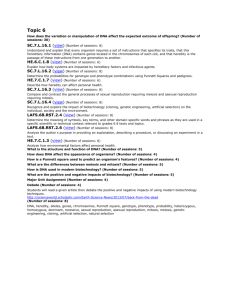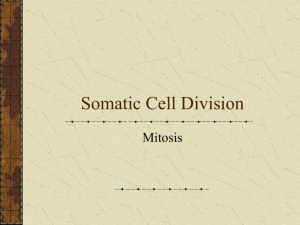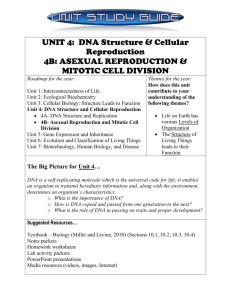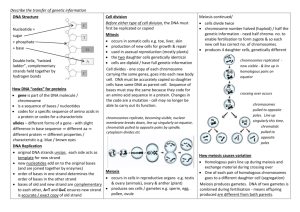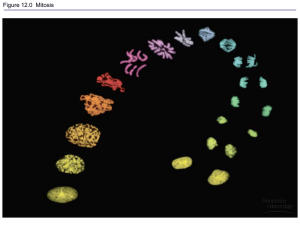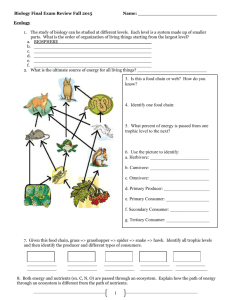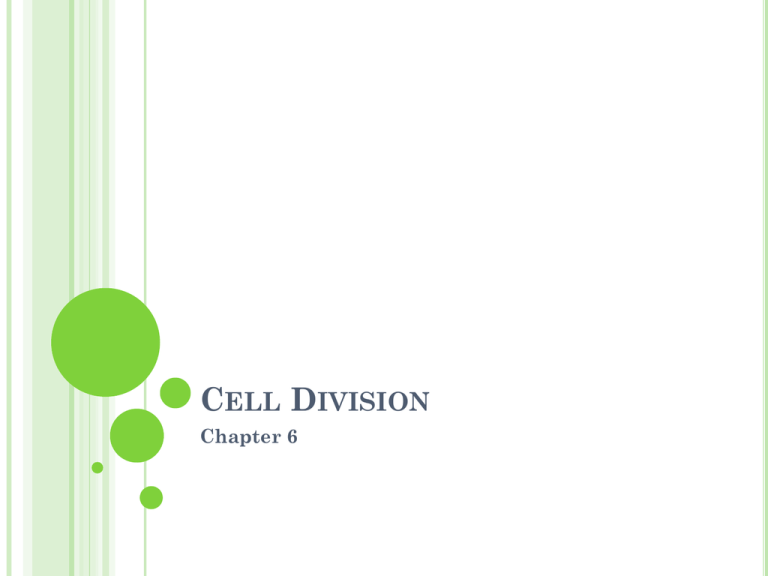
CELL DIVISION
Chapter 6
CELL DIVISION
Before cells can
divide, DNA has to
replicate itself so
there are 2 copies
DNA REPLICATION
DNA strand opens up
and DNA polymerase
attaches
The exposed unpaired
bases find new
partners
Growth of the DNA
replicates is always in
one direction
This means while one
side can grow as the
DNA unzips
The other side grows in
pieces that then must
be glued together
Errors are edited
TELOMERES
– TICKING CLOCK
Hutchinson-Gilford Progeria
Syndrome
MUTATIONS
Sometimes the errors result in proteins that don’t
work or don’t work as well
What causes a mutation?
Spontaneous
Radiation-induced mutations
Chemical-induced mutations
Sphinx mutation
ANIMAL CELLS HAVE “COUNTERS” THAT
KEEP TRACK OF HOW MANY TIMES A CELL
HAS DIVIDED. THESE COUNTERS ARE
CALLED:
A) odometers.
B) telomeres.
C) chromosomes.
D) nuclei.
E) centromeres.
IN DNA REPLICATION, WHEN THE DNA
MOLECULE SEPARATES INTO TWO STRANDS:
A) it is possible to reconstruct perfectly all the
information on the missing strand because one
strand carries all the information needed to
construct its complementary strand.
B) the rebuilding process begins, in which an
enzyme connects the appropriate
complementary base to the exposed base.
C) the mitotic phase of cell cycle begins.
D) All of the above are correct.
E) Only a) and b) are correct.
WITHIN INTERPHASE, WHICH OF THE STAGES
IS DEFINED BY THE ACTIVE REPLICATION OF
THE CELL’S GENETIC MATERIAL?
A) the Gap 2 phase
B) the mitotic phase
C) the Gap 1 phase
D) the replitosis phase
E) the DNA synthesis phase
2 DIFFERENT FORMS OF CELL DIVISION
Asexual reproduction and cell division of body
cells
Prokaryotes and some single celled Eukaryotes
All growing or repairing multi-cellular organisms
Binary fission
Mitosis
Sexual reproduction
Some single celled Eukaryotes
Conjugation
Eukaryotes
Meiosis
DIFFERENT FORMS OF CELL DIVISION
Asexual reproduction and cell division of body
cells
Prokaryotes and some single celled Eukaryotes
All growing or repairing multi-cellular organisms
Binary fission
Mitosis ***
Sexual reproduction
Some single celled Eukaryotes
Conjugation
Eukaryotes
Meiosis ***
MITOSIS
2 cells
Identical to Parent
THE PURPOSE OF MITOSIS IS TO ENABLE
EXISTING CELLS:
A) to generate gametes.
B) to grow.
C) to die on purpose.
D) to generate new, genetically identical cells.
E) to generate new, genetically diverse cells.
LET’S SEE THAT AGAIN - MITOSIS
End with 2 cells that are genetically identical to the
parent and to each other.
THIS FIGURE DEPICTS:
A) mitotic anaphase.
B) mitotic prophase.
C) mitotic metaphase.
D) mitotic telophase.
E) meiotic anaphase I.
SEXUAL
REPRODUCTION
& MEIOSIS
What would happen if
these cells were formed
by mitosis?
MEIOSIS - AGAIN
Only during the formation of eggs or sperm
Two divisions in one
At start – homologous chromosomes with their
replicates come together to form a tetrad (4)
Genetic recombination
First division – homologous chromosomes
separate
Second division – replicates separate
End up with 4 cells that are all genetically
different
= Oogenesis
Spermatogenesis
produces 4 cells all the
same size that then go on
to lose most of the
cytoplasm and get a tail
for swimming.
GENETIC RECOMBINATION – THE
REASON FOR SEX
PROJECT 3
Use the hand out or compare figures 6-11 and 620.
List all of the features that the two forms of division
have in common and explain these.
List all of the features found only in meiosis. Explain
your answers.
You may work in groups to develop your lists, but
hand in your own write-up either at the end of class
or at the start of the next class period.
KARYOTYPE
WHAT IS DIFFERENT ABOUT THIS
KARYOTYPE?
DOWN’S SYNDROME
Why are only smaller chromosomes ever seen in
trisomy?
WHICH OF THE FOLLOWING ARE FEATURES
THAT DISTINGUISH CANCER CELLS FROM
NORMAL CELLS?
A)Normal cells undergo cytokinesis; cancer cells do
not undergo cytokinesis.
B) Normal cells have contact inhibition; cancer
cells have no contact inhibition.
C) Normal cells metastasize; cancer cells do not
metastasize.
D) Normal cells can divide a finite number of times;
cancer cells can divide indefinitely.
E) Both b) and d) are correct.
A DIPLOID (2N) CELL UNDERGOES
MEIOSIS. WHAT ARE THE PRODUCTS OF
THIS DIVISION?
A) one polyploid gamete
B) four haploid cells
C) four diploid cells
D) two haploid cells
E) two diploid cells
THE EGG CELLS OF A HORSE CONTAIN
32 CHROMOSOMES. HOW MANY
CHROMOSOMES ARE IN THE HORSE’S
LIVER CELLS?
A) 32
B) 16
C) 128
D) 64
E) 8
READ CHAPTER 7 ON INHERITANCE OF
TRAITS

